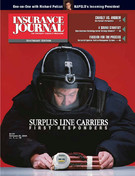Twelve years ago last month, Hurricane Andrew hit Homestead and became the costliest natural disaster in U.S. history.
Sadly, on this anniversary, thousands of Floridians again suffered the aftermath of another catastrophic storm.
On Aug. 13, Hurricane Charley mapped a destructive course from Sanibel Island through Fort Myers, Punta Gorda, Arcadia, Lakeland, Orlando and Daytona Beach. The destruction is overwhelming, and so are the emotions and hardships those residents and business owners are facing.
But there is good news. Because of what we learned from Hurricane Andrew, the victims of Hurricane Charley can look forward to rebuilding their lives and their businesses more quickly and with more coordinated assistance than before.
After Hurricane Andrew, it took weeks for relief supplies to be delivered and utilities to be restored. Fraud and price gouging were rampant. And, it was months before any reliable estimates were available on damages, both insured and economic.
This time, truckloads of water, food and other relief items were on the way before Hurricane Charley came ashore. Utility companies were immediately working to restore power, and recovery crews were removing trees and debris within hours of the storm’s landfall. Insurance specialists were dispatched the next day to expedite the filing of insurance claims, and teams of investigators were on-scene, creating a visible force against any would-be scam artists.
Perhaps more importantly, the response and coordination among federal, state and local officials has been tremendous.
Another stark contrast between Hurricane Andrew and Hurricane Charley is that Florida’s insurance industry is better prepared financially.
In the years before Hurricane Andrew, residential and commercial development had popped up along our shorelines and in our cities and towns. Every home and business was in search of property insurance protection and insurance companies were issuing policies hand over fist to keep up with the demand. At the time, Florida’s property insurance market was one of the most active and competitive in the nation.
In Hurricane Andrew’s wake, companies that took in $11 billion in premium the previous 20 years paid out $16 billion in insured losses, leaving over one million homeowners nearly stranded without insurance coverage.
Today, insurance companies are backed by a $15 billion Florida Hurricane Catastrophe Fund and are reserved to handle up to a $50 billion storm. An insurer of last resort is also in place. Citizens Property Insurance Corporation provides insurance to those with nowhere to turn to for coverage.
In retrospect, rates prior to 1992 were too low and in the years following Hurricane Andrew insurance rates were increased to meet the new reality Florida now faced. Having achieved rate adequacy, carriers now were reserving adequate amounts to be more prepared to absorb a catastrophic event. However, we often are the target of complaints that homeowner rates are too high. In fact, recently we read a letter to the editor that essentially claimed that Florida’s rates should be lowered because it has been 12 years since Hurricane Andrew: A week later Charley hit.
The good news—if there is any—is that overall we don’t anticipate any significant rate need as a result of Charley. We have long believed that pre-funding a catastrophe is far cheaper and lends much more stability to the market rather than post-funding an event.
Undoubtedly, we will learn new lessons from Hurricane Charley. But because of what we learned from Hurricane Andrew—that insurance companies, individual citizens,
and government officials at all levels are responsible for preparing for the immense costs of a major natural disaster—we can all look forward to a faster recovery from Hurricane Charley.
Editor’s note: Tom Gallagher is the state’s Chief Financial Officer and formerly served as Insurance Commissioner when Hurricane Andrew made landfall in Homestead on Aug. 24, 1992. Since this writing, Floridians have had to deal with Frances, which hit the Sunshine State earlier this month, and Ivan was lurking close behind. Visit www.insurancejournal.com for all the latest news.
Topics Catastrophe Florida Hurricane
Was this article valuable?
Here are more articles you may enjoy.


 California Surplus Lines Take-Up Soars as Brokers Work to Find Coverage for Clients
California Surplus Lines Take-Up Soars as Brokers Work to Find Coverage for Clients  People Moves: Consilium Taps Carpenter’s Coleman for C-Suite After Co-CEO Baird Suddenly Exits; Everest Promotes Shaw as Chief Commercial Officer of Int’l Division
People Moves: Consilium Taps Carpenter’s Coleman for C-Suite After Co-CEO Baird Suddenly Exits; Everest Promotes Shaw as Chief Commercial Officer of Int’l Division  Three Insurers Join Ward’s Annual Top 50 P/C Ranking for 2025
Three Insurers Join Ward’s Annual Top 50 P/C Ranking for 2025  New Book Proposes Four-Prong Legal Strategy to Negate Nuclear Verdicts
New Book Proposes Four-Prong Legal Strategy to Negate Nuclear Verdicts 


